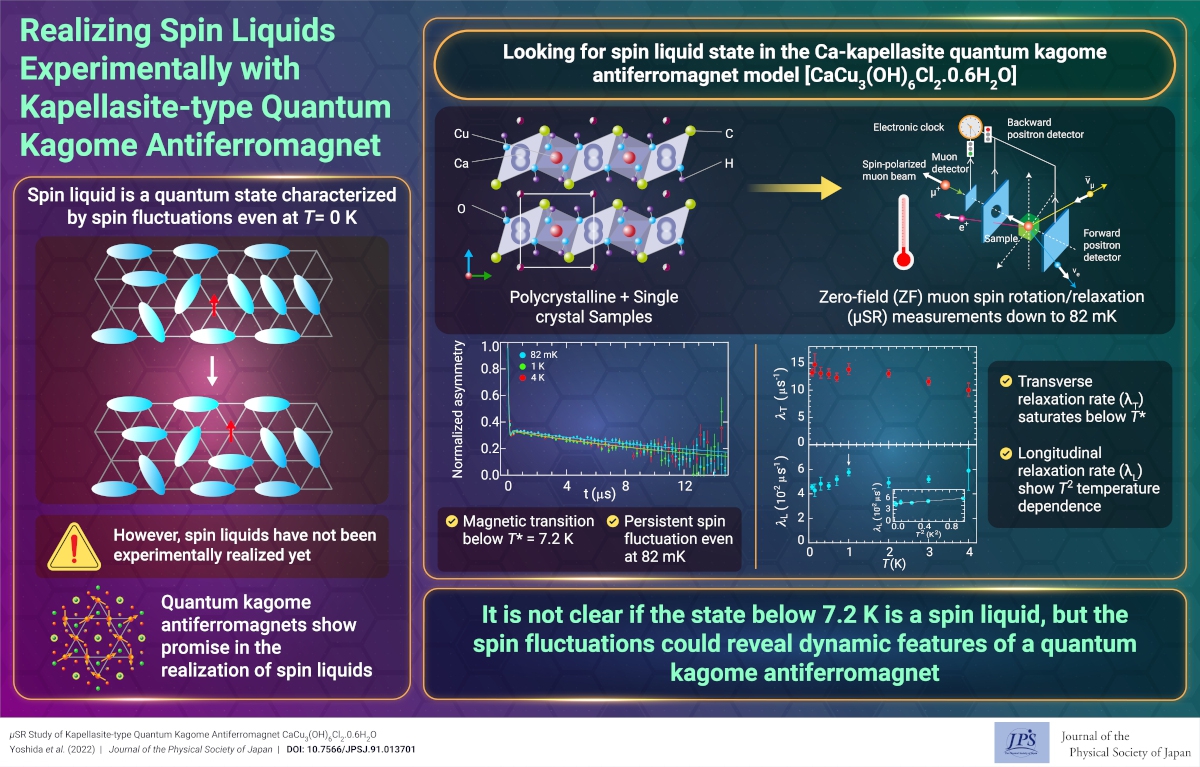Realizing Spin Liquids Experimentally with Kapellasite-type Quantum Kagome Antiferromagnet
© The Physical Society of Japan
This article is on
μSR Study of Kapellasite-type Quantum Kagome Antiferromagnet CaCu3(OH)6Cl2∙0.6H2O
(JPSJ Editors' Choice)
J. Phys. Soc. Jpn. 91, 013701 (2022).
This study reports the observation of the spin fluctuation in a quantum kagome antiferromagnet CaCu3(OH)6Cl2·0.6H2O which persists down to 82 mK using the μSR technique.

At ambient pressure, water has three states depending on the temperature; gaseous (water vapor), liquid (water), and solid (ice) states. Below 0 °C, water freezes to form ice which comprises crystals with molecules arranged periodically. Electron spins, which are responsible for the magnetism of materials, have similar thermodynamic properties. In general magnets, the paramagnetic (gaseous) state is stable at high temperatures in which the electron spins have random directions, whereas when the temperature is lowered, a phase transition occurs at a certain critical temperature to the magnetically ordered (solid) state in which the electron spins exhibit a periodical alignment. The magnetically ordered (solid) state is, for instance, a ferromagnetic state in which all the electron spins are aligned in one direction or an antiferromagnetic state in which all the neighboring spins point in opposite directions. By controlling and utilizing these magnetic states, modern electronics has progressed exponentially. Recently, the "magnetic frustration" effect, which prevents such electron spins from forming a solid state, has been actively investigated, and the realization and potential applications of the spin liquid state which is "a liquid state of electron spins" caused by the frustration effect have garnered significant interest.
In a spin liquid state, the spins continue to fluctuate without freezing even at absolute zero. The most famous model of the spin liquid state is the resonant valence bond (RVB) state proposed by Nobel laureate P.W. Anderson in 1973, and its relevance to the mechanism of high-temperature superconductivity and the feasibility of quantum computing using fractional excitations and associated quantum entanglement of the spin liquid state. Therefore, the realization and clarification of the spin liquid state is one of the most important issues in modern physics.
The authors have focused on Ca-Kapellasite (CaCu3(OH)6Cl2·0.6H2O) as a model material for a quantum kagome antiferromagnet, which has a strong frustration and is expected to be an excellent candidate for the spin liquid state. The spin dynamics of this material has been investigated in detail down to the extremely low temperature of 82 mK through the μSR technique. It has been elucidated from the magnetization measurements that Ca-Kapellasite exhibits magnetic order at 7.2 K. Therefore, it appears to be a magnetic material that can be described by the mean-field approximation of classical spin systems. However, the proposed μSR experiments revealed that the spins were fluctuating even in the magnetically ordered state. This indicates the dynamic aspect of the magnetic state of a quantum kagome antiferromagnet. It is expected that the development of chemically modified samples and related materials, as well as precise measurements of the physical properties, will significantly advance the understanding of the physics of kagome spin liquids.
(Written by H. K. Yoshida on behalf of all authors)
μSR Study of Kapellasite-type Quantum Kagome Antiferromagnet CaCu3(OH)6Cl2∙0.6H2O
(JPSJ Editors' Choice)
J. Phys. Soc. Jpn. 91, 013701 (2022).
Share this topic
Fields
Related Articles
-
Exploring Electronic States in BEDT-TTF Organic Superconductors
Superconductivity
Electronic transport in condensed matter
Magnetic properties in condensed matter
2024-4-24
This review, published in the Journal of the Physical Society of Japan, provides a comprehensive summary of the electronic states observed in BEDT-TTF type organic superconductors, including metal-insulator transitions, Mottness transitions, non-Fermi liquids, quantum spin liquids, and Bose-Einstein condensation.
-
Variety of Mechanically Induced Spin Currents in Rashba Systems
Electronic transport in condensed matter
Magnetic properties in condensed matter
Structure and mechanical and thermal properties in condensed matter
2024-3-22
Various types of spin currents, including unconventional types, are generated in Rashba spin-orbit coupled systems by dynamic lattice distortions associated with, for example, surface acoustic waves.
-
Current Melt Frozen Electrons
Dielectric, optical, and other properties in condensed matter
Magnetic properties in condensed matter
2024-1-15
The origin of the current-induced insulator-to-metal transition of samarium monosulfide was explained by the 4f−5d hybridization observed using optical reflectivity and photoelectron spectroscopies.
-
Towards Uncovering the Hidden Order of URu2Si2 Phase Transition
Magnetic properties in condensed matter
Electronic structure and electrical properties of surfaces and nanostructures
2024-1-11
We propose a chiral charge as the hidden order parameter in URu2Si2 and present experiments to detect it by focusing on breakings of mirror and inversion symmetries at the local uranium ion.
-
Magnetic Excitation in S = 1/2 Antiferromagnetic Chain CsCoCl3 with Ising-Like Exchange Interaction
Magnetic properties in condensed matter
2023-11-13
The results of high-field electron spin resonance measurements in the millimeter-wave to terahertz region reveal unconventional magnetic excitation in S = 1/2 one-dimensional antiferromagnets.
